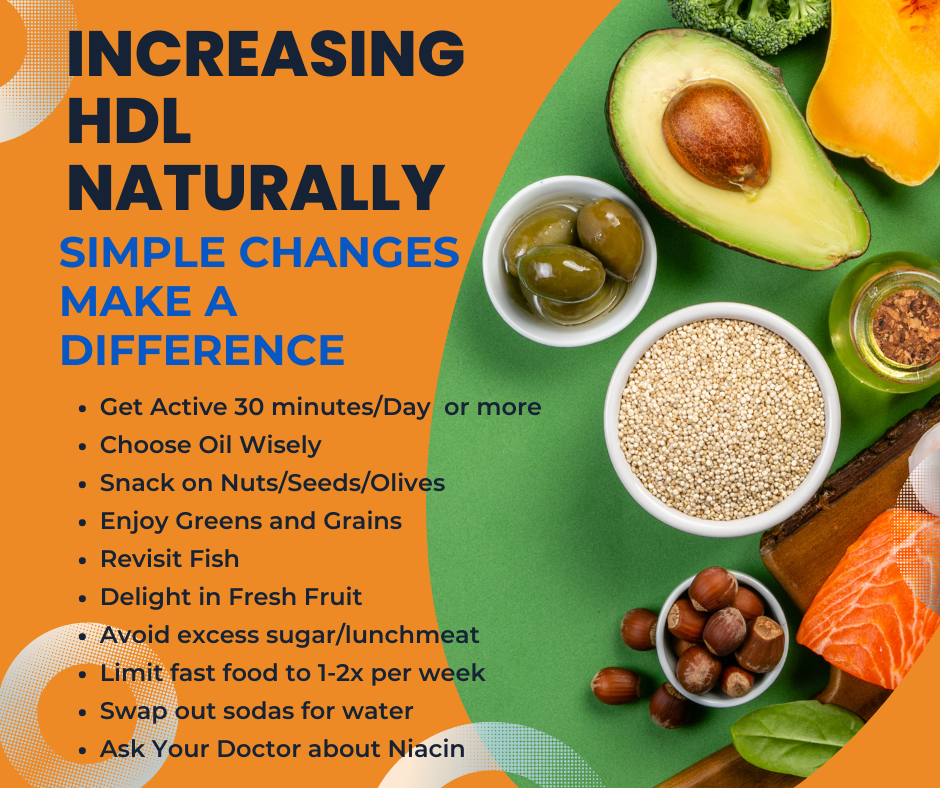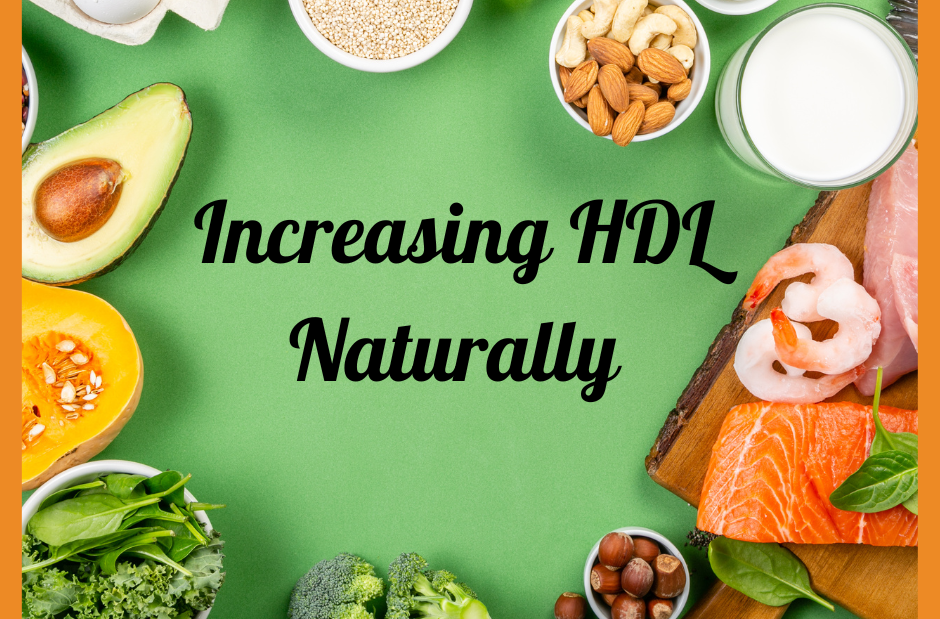Increasing HDL-C naturally sounds like a difficult task. After all, statin therapies are known to lower low-density lipoproteins (LDL) rather than high-density lipoproteins. Since higher levels of HDL are associated with decreased cardiovascular disease risk, it makes sense to explore what the literature says about increasing it naturally.
HDL is credited for moving excess low-density lipoproteins to the liver and normalizing blood cholesterol. This is good news for those who have an ideal level 60mg/dL or higher. But why is HDL so important?
HDL plays a role in moving the cholesterol out of the artery wall. However, more importantly, is its ability to reduce oxidation, inflammation and thrombosis, improve the lining of the arteries, enhance insulin sensitivity, and increase production of insulin by the beta cells in the pancreas. (1)
Increasing ApoA-1 is also a consideration because it is the primary structural apolipoprotein associated with HDL to reduce cardiovascular risks, making up to 70% of HDL protein.
*Please note: none of the studies funded by Pfizer, Astra Zenica, Eli Lily, or others were referenced in this research article.*
Increasing HDL with Lifestyle
- Exercise Moderate intensity workouts (Walking, biking, swimming, hiking, and weight training, etc.) has been shown to increase HDL-C and decrease Triglyceride/HDL ratios. (2,7) The American Heart Association recommends 40 minutes of moderate to vigorous exercise 3-4 days per week. Ideally, getting a vigorous workout involves raising resting heart rate to a person’s target heartrate. The age predicted target heart rate can be calculated by decreasing your age from 220. (4) Of course, we have to consider how medications, stress, hormones, and individual activity levels affect heart rate in varying degrees.
- Quit smoking– Smoking is associated with reduced levels of ApoA-1 and HDL. (4)
- Mediterranean Diet (Consists of more fish, true healthy fats like olive oil, vegetables and whole food). (5)
- Increase Omega 3 Fatty Acids (Salmon, tuna, sardines, approved supplements from a healthcare provider). (6)
- Avoid Hydrogenated Oils (margarines, biscuit mixes, doughnuts, processed cakes, cookies, pastries, crackers).
- Avoid Seed Oils that are inflammatory The Western Diet is high in vegetable seed oils (canola, soybean, cottonseed, sunflower, corn oils) In some studies, seed oils show increased neuropil counts when exposed to seed oils (7) In others, substances called hydroxynoneal particles leads to cell death. (11)
- Limit or Avoid Alcohol For men the boundary for this is no more than two drinks per day and for women one drink per day. A serving size of alcohol is: 5 ounces of wine, a 12 ounce beer, and 1.5 ounces of hard/distilled liquor.
- Whole Grains (Oats, Wheat, Barley, Quinoa) The fiber, vitamins, and minerals present in whole grains are thought to raise HDL by helping to decrease homocysteine levels, decrease inflammation, and improve blood vessels. (9)
- Eat Beans and Legumes- to increase fiber and reduce LDL cholesterol.
- Apply Flax seed meal to muffins, oats, or hot cereal for more fiber.
- Enjoy a Serving a day of Nuts (Walnuts, pistachio, Brazil nuts, or almonds).
- Apply a Serving or Two of Seeds to Salads, hot cereals, soups. (Chia, Hemp seeds, sunflower seeds, hulled pumpkin seeds).
- Avocados–in 7 studies increased HDL without affecting triglycerides or LDL. (8)

Increasing HDL-C with Doctor Approved Supplements
- Niacin
One PubMed source credits niacin as “the most effective agent for raising HDL-C” (3) Another says it raises HDL by 25%. It has a direct effect on ApoA-1 stability and function. (10) - Nutraceuticals (A combination of Plant phytosterols/red yeast rice//27mg niacin/) in a randomized double-blind trial significantly lowered LDL-C and Triglycerides.
Summary
There are ways to increase HDL cholesterol naturally. It is well known throughout the global community that the Standard American Diet of ultra-processed food, sugar, fat, and preservatives contribute to cardiovascular disease. My friend, God has a better plan for you and me and our food intake. He created everything we need the third day in the garden to heal and sustain our blood vessels.
The land produced vegetation: plants bearing seed according to their kinds and trees bearing fruit with seed in it according to their kinds. And God saw that it was good.
Genesis 1:12
All we have to do it enjoy a wide variety of nutrient rich items daily. If you need help with getting a plan together, we can do that together. Contact me for a free 30-minute consultation. In the meantime, enjoy heart healthy whole food recipes from the blog!
Take care!
Mysty,
Simplifying Health God’s Way
References:
Anderson JW. Whole grains protect against atherosclerotic cardiovascular disease. Proc Nutr Soc. 2003 Feb;62(1):135-42. doi: 10.1079/PNS2002222. PMID: 12740068
2) Barter P. HDL-C: role as a risk modifier. Atheroscler Suppl. 2011 Nov;12(3):267-70. doi: 10.1016/S1567-5688(11)70885-6. PMID: 22152280.
3) Cziraky MJ, Watson KE, Talbert RL. Targeting low HDL-cholesterol to decrease residual cardiovascular risk in the managed care setting. J Manag Care Pharm. 2008 Oct;14(8 Suppl):S3-28; quiz S30-1. PMID: 19891279.
4)Grao-Cruces E, Varela LM, Martin ME, Bermudez B, Montserrat-de la Paz S. High-Density Lipoproteins and Mediterranean Diet: A Systematic Review. Nutrients. 2021 Mar 16;13(3):955. doi: 10.3390/nu13030955. PMID: 33809504; PMCID: PMC7999874.
5) Kanikowska D, Kanikowska A, Rutkowski R, Włochal M, Orzechowska Z, Juchacz A, Zawada A, Grzymisławski M, Roszak M, Sato M, Bręborowicz A, Witowski J. Amaranth (Amaranthus cruentus L.) and canola (Brassica napus L.) oil impact on the oxidative metabolism of neutrophils in the obese patients. Pharm Biol. 2019 Dec;57(1):140-144. doi: 10.1080/13880209.2019.1569696. PMID: 30905230; PMCID: PMC6442228.
6) Kauss AR, Antunes M, de La Bourdonnaye G, Pouly S, Hankins M, Heremans A, van der Plas A. Smoking and apolipoprotein levels: A meta-analysis of published data. Toxicol Rep. 2022 May 17;9:1150-1171. doi: 10.1016/j.toxrep.2022.05.009. PMID: 36518393; PMCID: PMC9742875.
7) Liang M, Pan Y, Zhong T, Zeng Y, Cheng ASK. Effects of aerobic, resistance, and combined exercise on metabolic syndrome parameters and cardiovascular risk factors: a systematic review and network meta-analysis. Rev Cardiovasc Med. 2021 Dec 22;22(4):1523-1533. doi: 10.31083/j.rcm2204156. PMID: 34957791.
8) Mahmassani HA, Avendano EE, Raman G, Johnson EJ. Avocado consumption and risk factors for heart disease: a systematic review and meta-analysis. Am J Clin Nutr. 2018 Apr 1;107(4):523-536. doi: 10.1093/ajcn/nqx078. PMID: 29635493.
9) Muscella A, Stefàno E, Marsigliante S. The effects of exercise training on lipid metabolism and coronary heart disease. Am J Physiol Heart Circ Physiol. 2020 Jul 1;319(1):H76-H88. doi: 10.1152/ajpheart.00708.2019. Epub 2020 May 22. PMID: 32442027.
10) Romani M, Hofer DC, Katsyuba E, Auwerx J. Niacin: an old lipid drug in a new NAD+ dress. J Lipid Res. 2019 Apr;60(4):741-746. doi: 10.1194/jlr.S092007. Epub 2019 Feb 19. PMID: 30782960; PMCID: PMC6446705.
11) Yamashima T, Ota T, Mizukoshi E, Nakamura H, Yamamoto Y, Kikuchi M, Yamashita T, Kaneko S. Intake of ω-6 Polyunsaturated Fatty Acid-Rich Vegetable Oils and Risk of Lifestyle Diseases. Adv Nutr. 2020 Nov 16;11(6):1489-1509. doi: 10.1093/advances/nmaa072. PMID: 32623461; PMCID: PMC7666899.






